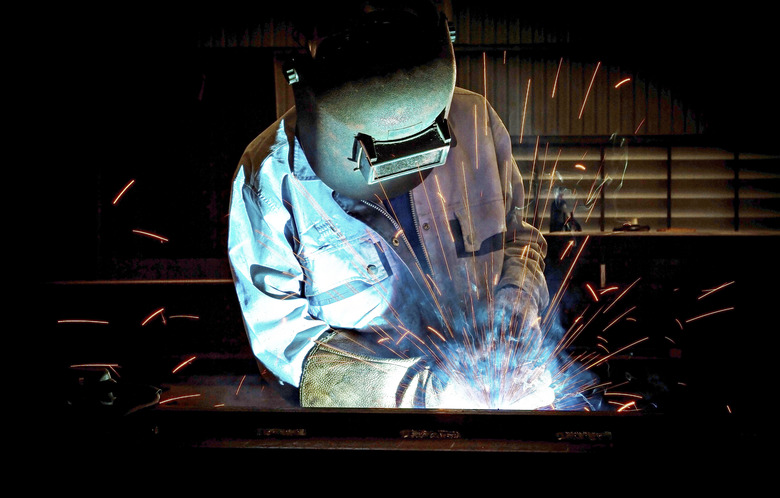How To Weld Aluminum With An ARC Welder
Arc welding has been historically important to construction since its common adoption in the 19th century. Today, it is a crucial component of the fabrication of both buildings and vehicles. Steel is most commonly used for welding tasks, but certain situations call for aluminum, which is notably more difficult to work with than steel. However, with the right approach and planning, you can do aluminum arc welding easily, whether the task is at a work site or in a hobbyist's workshop.
TL;DR (Too Long; Didn't Read)
Aluminum's properties make it a more difficult metal to weld than steel: It expands more in response to heat, and it's lower melting temperature makes it significantly easier to melt an entire piece of metal during the welding process. However, if you do the weld with attention and at the correct speed and temperature, aluminum can be arc welded through either the heliarc or stick welding methods. Be _incredibly_ careful when arc welding, and _never_ look at an arc without eye shielding.
Arc Welding Basics
Arc Welding Basics
Though developments in technology over the last century have allowed for the creation of automatic welders and more efficient welding machines, the basic process of arc welding has remained the same. Arc welding is a process of fusing two pieces of metal together through the use of an electric arc, which creates an intense heat capable of melting the metal parts. When melted with a specially coated electrode, the molten metal is mixed with a filler that binds the two parts into a single unit. Various methods of arc welding exist, based on the techniques and materials involved in the process.
Aluminum Troubles
Aluminum Troubles
Steel is often considered the 'default' metal to use during welding, and in comparison, aluminum is a notoriously difficult metal to bind with an arc welder. As an active metal with a tendency to form oxides, it is harder to create a binding filler suitable for welding aluminum. When combined with the metal's high heat conductivity and low melting point, it is very easy for a novice welder to completely melt the aluminum pieces involved in the process. As a result, the first step to arc welding aluminum is to clean the base metal of any oxides or solvent oils. The second step is to be mindful of your approach.
Stick Welding
Stick Welding
Shielded metal arc welding (SMAW), informally known as stick welding, is one of the older forms of arc welding. Inexpensive and easy to perform in a wide variety of environments, this welding technique is often reserved for small fabrication shops and hobby welders but can be used to weld aluminum together smoothly. The key is to use a more powerful, direct current welder and an aluminum-coated electrode. By welding quickly, without giving the metal too much contact with the arc, the aluminum can be bound quickly.
Heliarc Welding
Heliarc Welding
Gas metal arc welding (GMAW), informally called Heliarc welding, is a process of welding that adds inert gas, such as argon or helium, in order to ensure that oxidation does not occur during the melting process. To weld aluminum with this method, it is best to preheat the metal to no more than 230 degrees Fahrenheit before beginning the weld. By using argon gas and pushing rather than pulling the welding gun away from the weld puddle, aluminum can be bound without much trouble.
References
- Lincoln Electric: A Guide to Aluminum Welding
- ESAB: A short history of welding aluminum
- Howcast: How to Arc Weld
- Tulsa Welding School: Different Types of Arc Welding
- Weld.com: Stick Welding Aluminum
- Stick Welding Tips and Tricks: Stick Welding Aluminum & Weird Trick
- The Fabricator: Aluminum Workshop – Aluminum arc welding with other processes
- Lincoln Electric: Arc Welding Fundamentals
Cite This Article
MLA
Flournoy, Blake. "How To Weld Aluminum With An ARC Welder" sciencing.com, https://www.sciencing.com/weld-aluminum-arc-welder-2385/. 4 June 2018.
APA
Flournoy, Blake. (2018, June 4). How To Weld Aluminum With An ARC Welder. sciencing.com. Retrieved from https://www.sciencing.com/weld-aluminum-arc-welder-2385/
Chicago
Flournoy, Blake. How To Weld Aluminum With An ARC Welder last modified March 24, 2022. https://www.sciencing.com/weld-aluminum-arc-welder-2385/
